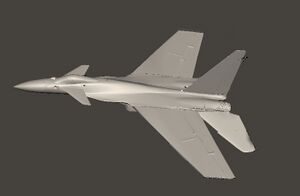AC-88 Taipan
Page Template:Infobox aircraft/styles.css has no content.
| AC-88 Taipan | |
|---|---|
 Illustration of the IEK-88 Taipan in Aéroforça Gray Spectacled | |
| General information | |
| Type | Air-Superiority Fighter |
| Manufacturer | Incorporaçion Estavez-Colón (IEK) |
| Status | In service |
| History | |
| Manufactured | 1997-present |
| Introduction date | 1998 |
The AC-88 Taipan is an air-superiority fighter developed by Inyursta for the Inyurstan Air Force, and later Inyurstan Navy. It is named after the Taipan, a genus of highly venomous and formidable snakes.
Development
The Taipan program began as an indigenous effort to develop a 4th-Generation "pure" air-superiority fighter along the same lines as the original F-15. Designers and engineers also borrowed the same phrase "not a pound for air-to-ground" when describing the duties and expected roles of the Taipan. Russian defector and former Sukhoi engineer Vasily Kalmov was instrumental in providing information and ideas gleaned from the Flanker family into the program. The resulting AC-88 is considered a "hybrid" aircraft, due to the input and influence of both Western and Eastern Bloc sources.
In December of 1996, the original X-88 prototype made its maiden flight, performing several sonic booms, Herbst Maneuvers and Pugachev's Cobra. It was soon after ordered into production and adopted by the Inyurstan Air Force.
Design
Main design features of the Taipan include both the presence of forward canards and a Leading Edge Extension (LERX). It also features a forward air brake and thrust-vectoring engines; all features which give it super-maneuverable capabilities.
Original models carried the ESQ/AS-1 Razor radar, an infant project giving the Taipan a radar range of roughly 100km against 3m2 targets and without IRST systems; however both features would later be improved upon with future models.
The AC-88E Taipan Block II was a significant upgrade over the A-model and B-model designs, featuring the major additions of the Nihonese Kojima K50 variable-cycle engines, the AN/APG-77v1 radar and the CAT EYE passive IRST. With the addition of the 170kn thrust K50, the C-model achieved supercruise capability. This came along with the upgraded AN/APG-77v1 radar, which allowed it to detect targets well beyond 300km with a low-intercept probability. These combined characteristics gave the upgraded Taipan Block II functionality as an interceptor in addition to its air-superiority role.
Current models of the AC-88 are equipped with the LIDACS-II Counter-Measure Suite.
History
The Lolloh-Ruol Wars became the first conflict for the Taipan's to see combat. They proved quite successful at surviving onslaughts of both Cold War-era relic fighters and modern 4.5 and 5th-gen aircraft in both medium-range ("short BVR") and short-range engagements.
Due to the lessons learned in the Lolloh-Ruol Wars, designers and military strategists began scheming with the idea of using the Taipan as an interceptor to destroy bombers and C4ISTAR assets. Tests were done with the American AIM-54 Pheonix integrated onto the AC-88, and such load outs saw limited use in combat; however, they would later pave the way for the integration of the C-300 Scapèle onto the aircraft.
In the Greco-Bulgarian War they were deployed but to limited use and effect due to the relative lack of hostile air targets.
The AC-88E Taipan Block II made its debut and served as the backbone of Inyurstan support during the DEN Invasion of Colombia.
AC-88E Taipan's of both Inyurstan and Cuscatlani origin were responsible for the interception of two Hayesalian CBU-160 Super Blackjack bombers during the San Meresque Incident.
Variants
X-88: Radar-less technology demonstrator
AC-88A/B: Standard model put into production 1997.
AC-88C/D Block I: Added additional IRST systems
AC-88E Block II: Added improved engines and AN/APG-77v1 radar.
AC-88N "Seasnake": Naval aviation variant with tail hook and folding wings (Block II standard).
AC-88ACF Block III "Super Taipan": Proposed legacy upgrade which would feature lower RCS, improved engines, and increased payload.
Specifications
Crew: 1
Speed: Mach 2.4 (mph; km/h)
Combat Radius: 1,100km with standard load-out and no external fuel tanks
Range: >3,000km
Payload: 5,500kg
Hardpoints:
- x3 Undercarriage
- x6 Underwing
- x2 Wingtip
Armament:
Air-to-Air
- AIM-120 AMRAAM
- AIM-54 Pheonix
- AIM-9 Sidewinder
- C-300 Scapèle XLRAAM
- C-120 Rapier
- C-170 Rapier II
- C-80 Stilétto
- Python Family